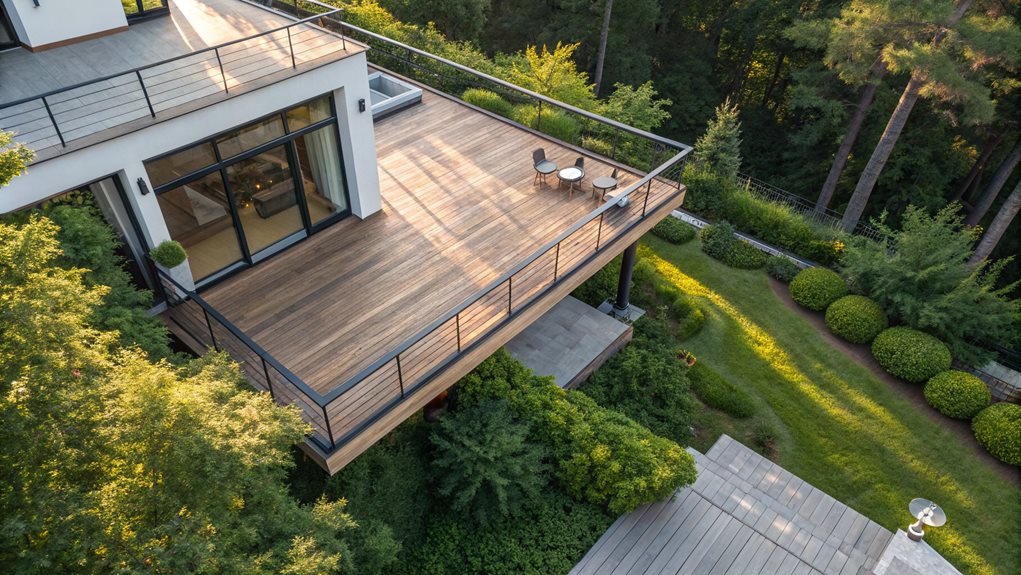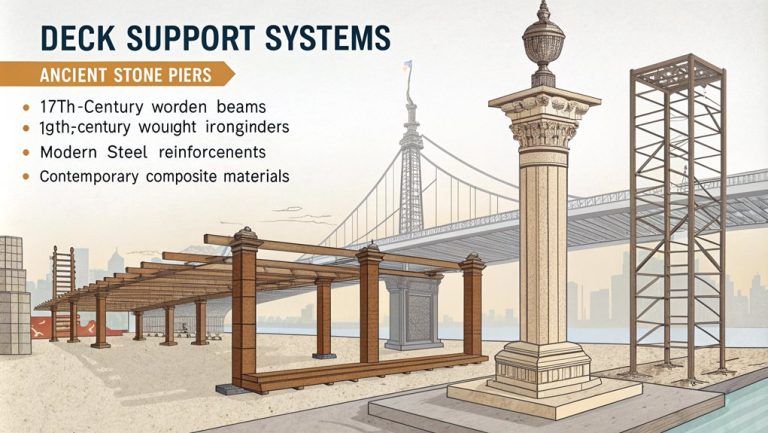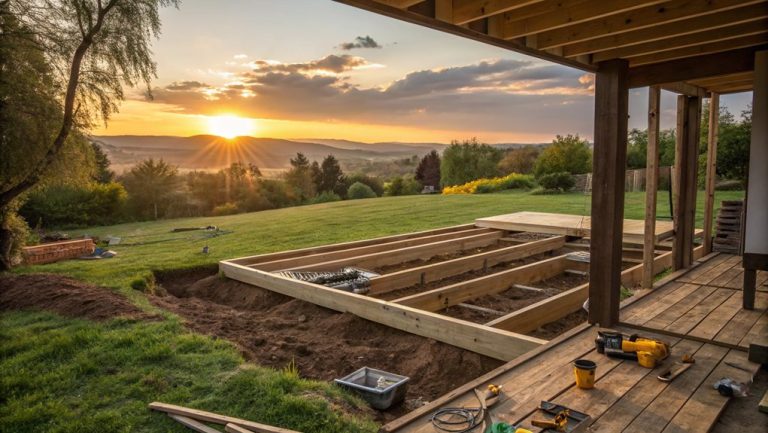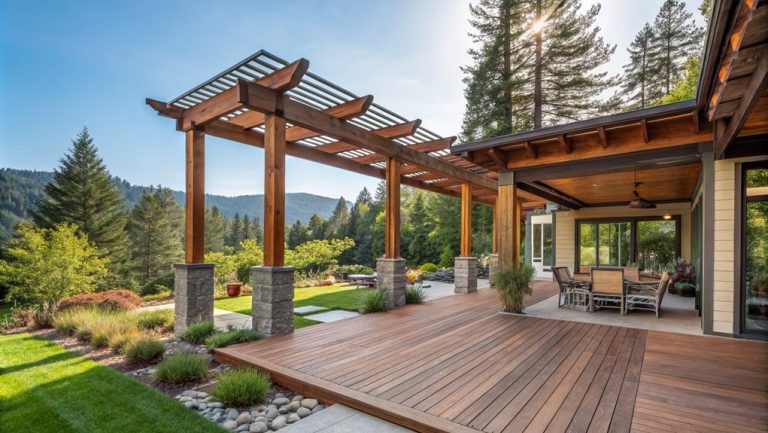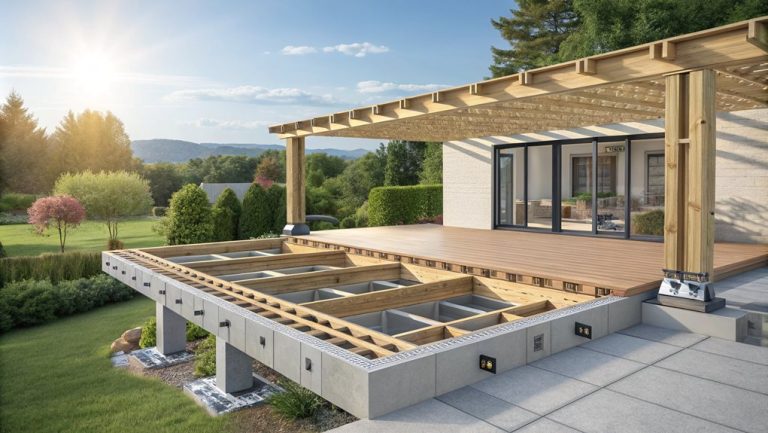Why You Should Invest in Quality Support Materials for Your Deck
Investing in quality support materials for your deck is essential for long-lasting durability and safety. High-grade options like composite, aluminum, and PVC greatly resist rot, mold, and insect damage, particularly beneficial in various climates. These materials also adhere to local building codes, ensuring structural integrity by preventing issues like warping or corrosion. They enhance visual appeal through diverse colors and finishes while minimizing maintenance, consequently saving time and money in the long run. Well-chosen materials reduce potential safety hazards and extend your deck's lifespan. Understanding these benefits will guide you in achieving a safe and attractive deck space.
Expert Highlights
- Quality materials ensure deck durability, resisting rot, mold, and insect damage.
- Investing in premium support materials enhances deck safety, complying with building codes.
- High-grade support materials prevent structural failures and potential collapses.
- They improve deck aesthetics, offering customizable, appealing designs.
- Low-maintenance materials minimize repair efforts and extend the deck's lifespan.
Ensuring Deck Durability
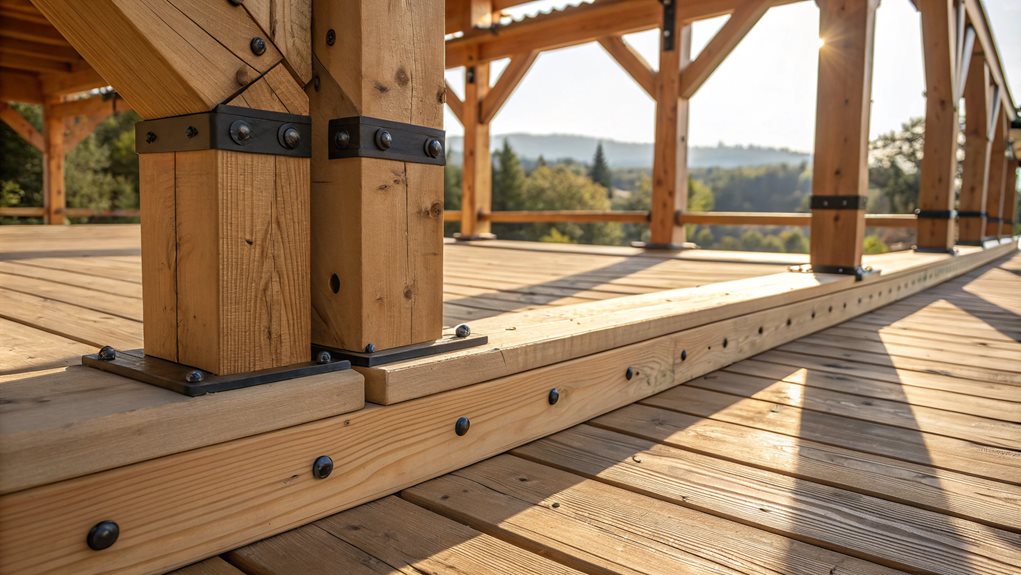
How can one guarantee the longevity and strength of a deck amidst varying environmental pressures? Selecting the appropriate materials is vital. Composite decking, crafted from wood fibers and recycled plastics, offers excellent resistance to rot, mold, and insect damage. Modern decking materials are known for having enhanced durability, making them ideal for outdoor use. It also withstands fading, warping, and cracking in diverse climates. PVC decking, made from polyvinyl chloride, excels in humid and coastal areas, resisting moisture and UV-induced fading. Aluminum decking provides remarkable resilience, enduring extreme weather without warping or corrosion. Hardwood decking boasts incredible strength from its dense grain, although it requires regular maintenance to combat freeze-thaw cycles. Due to the demand for weather resistance in outdoor spaces, pressure-treated lumber remains a popular choice because it is remarkably weather-resistant, reducing warping and rot risks. For those looking to transform their home into an outdoor living oasis, innovative deck builders offer custom solutions aligning with individual preferences and environmental needs. Each material serves different needs, ensuring your deck remains robust and enduring.
Enhancing Safety Standards
Enhancing safety standards] in deck construction is essential to preventing structural failures and reducing accident risks, ensuring the long-term stability of the deck. Local building codes and standards such as the International Residential Code (IRC) provide guidance on the specific dimensions, materials, and structural elements needed for safe construction. Key elements such as secure footings, proper attachment of ledger boards, and adherence to load capacity guidelines play pivotal roles in maintaining structural integrity. Additionally, deck professionals who are knowledgeable about building codes and industry best practices can further contribute to safety by ensuring that all aspects of the deck construction adhere to the most recent regulations. Furthermore, utilizing corrosion-resistant fasteners can significantly enhance the durability and safety of the deck by preventing decay and preserving structural connections. Additionally, regular inspections and compliance with both international and local building codes are indispensable practices to address potential safety hazards and uphold high safety standards.
Preventing Structural Failures
Structural integrity is paramount in deck construction, necessitating adherence to rigorous safety standards to prevent failures. Proper ledger board installation is indispensable, as it links the deck to the house, eliminating pull-away risks. Compliance with modern building codes is essential, utilizing tension ties like Simpson StrongTie DTT1Z or engineered fasteners such as LedgerLok for corrosion resistance. Ensuring effective flashing and waterproofing is critical, protecting against moisture-induced wood rot. Using Trex Seal tapes over ledger boards enhances waterproofing capabilities. Regular maintenance, including annual inspections, maintains safety standards by identifying and repairing potential issues. Employing quality materials guarantees your deck remains a safe, integral gathering place for your community.
| Consideration | Recommended Products | Purpose |
|---|---|---|
| Ledger Board Fasteners | Simpson StrongTie DTT1Z, LedgerLok | Prevent pull-away failures |
| Flashing Materials | Trex Seal tapes, waterproof joist tape | Waterproofing, prevent rot |
| Fastener Type | SPAX corrosion-resistant screws, stainless steel | Prevent rust, easy installation |
Reducing Accident Risks
When it comes to reducing accident risks in deck construction, understanding common hazards is indispensable. With over 6,500 injuries reported annually, primarily from collapses, it is clear that evaluating potential dangers is pivotal.
Aging decks, especially those over two decades old, face higher risk. Key issues include improperly installed ledger boards, often securing the deck inadequately, and railings fastened with rusty nails. Environmental factors like excess moisture can exacerbate structural weaknesses.
Consequently, investing in quality materials to secure deck connections is essential. Bolts, rather than nails, should anchor ledger boards. Regular inspections for corrosion and decay in fasteners are paramount. By addressing these hazards, you uphold safety standards and maintain your deck as a secure gathering place.
Ensuring Deck Stability
A critical aspect of deck construction is guaranteeing deck stability, which fundamentally involves the proper attachment and alignment of its supporting components. Ledger boards, indispensable for stability, must be affixed to the house using bolts, not nails, to prevent collapses. Regular inspections are necessary to check these connections for decay or loosening, ensuring water drainage to avoid rot.
Posts and beams require secure connections using metal connectors or notched joints. Appropriately sized joists distribute weight evenly, preventing sag. Adhering to building codes is paramount; they specify the requirements for safe construction, and compliance prevents hazards. Regular maintenance, including checking for rot and corrosion, assures ongoing safety. Quality, corrosion-resistant materials reinforce the deck's structural integrity, fostering a secure environment for all.
Boosting Visual Appeal

Boosting visual appeal in deck construction involves selecting materials that not only perform well but also enhance the overall aesthetic of outdoor spaces. Steel deck framing, known for its smooth lines and industrial look, provides a striking contrast against other deck elements. Its black powder coating adds enduring charm, appealing to homeowners who value an exposed steel aesthetic.
Composite decking offers long-lasting allure with minimal upkeep, combining wood fibers and plastic to resist decay while offering a variety of colors and finishes. Wood decking, with its traditional charm, showcases natural grains and a weathered elegance.
For contemporary styles, metal decking like aluminum offers sleekness, while PVC decks provide varied, durable color choices. Each option supports a distinctive visual philosophy, ensuring your deck complements its surroundings. Personalizing your deck with custom-designed elements enhances both its beauty and functionality, seamlessly integrating it with your home's architecture while extending your living space outdoors.
Reducing Maintenance Efforts
Maintaining a deck's condition without excessive effort is achievable by focusing on strategies that reduce the accumulation of debris and prevent water damage. Regular sweeping removes dirt and debris, while a putty knife effectively clears debris between boards. Keeping trees trimmed and mulch at a distance prevents moisture buildup. Redirecting downspouts and ensuring proper flashing on ledger boards are essential for minimizing water-related issues. Regular inspections of handrails and posts, coupled with timely repairs, safeguard against rot. Annual deck cleaning with appropriate methods such as low-pressure washing and applying brighteners maintains its appearance. When investing in a cedar deck, the natural resistance to rot and decay can significantly minimize the effort needed for upkeep. Reinforcing structural integrity by inspecting connections, tightening fasteners, and replacing decayed components establishes a robust framework. This proactive maintenance framework simplifies upkeep and extends the deck's lifespan.
Achieving Cost-Effectiveness
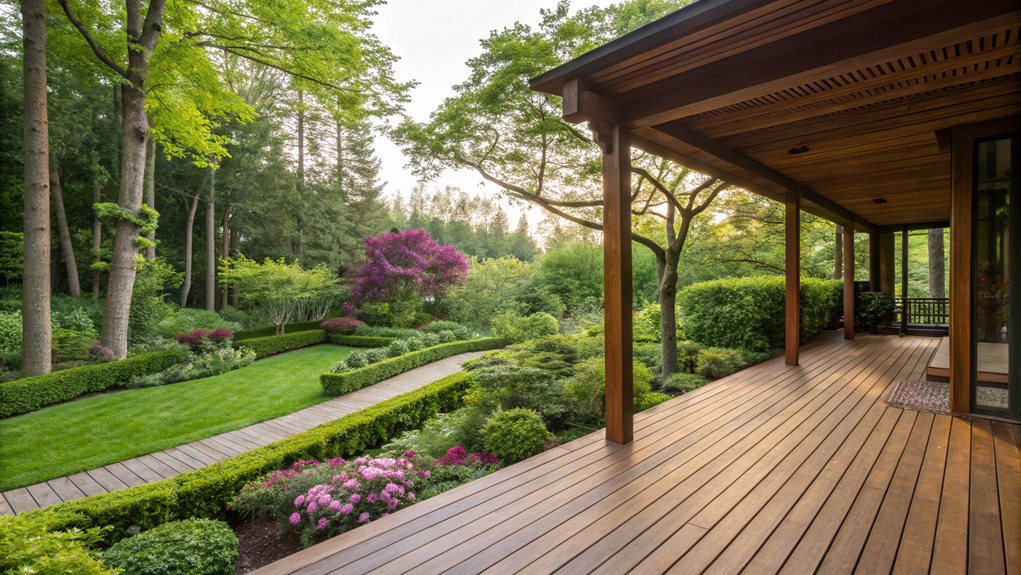
When considering cost-effectiveness in deck support materials, the balance between upfront expenses and long-term financial benefits plays a critical role. While pressure-treated wood offers the lowest initial cost, its ongoing maintenance needs can lead to increased cumulative expenses over time. In collaboration with designers, premium decking materials ensure a perfect blend of functionality and elegance, enhancing both aesthetics and longevity. In contrast, composite and vinyl decking, despite their higher initial costs, provide substantial savings through lower maintenance expenses and longer lifespans, making them lucrative options for achieving long-term financial efficiency.
Long-Term Financial Benefits
A homeowner's decision to invest in high-quality deck support materials can yield considerable long-term financial benefits. A well-constructed deck adds substantial resale value, with potential recoupment of up to 75% of its investment, according to the National Association of Realtors. This increase in property value can greatly enhance the appeal of a home to prospective buyers.
Moreover, the durability of materials like pressure-treated wood and composite decking guarantees longevity, with composite decks often lasting 25-30 years. This longevity minimizes the cost of frequent repairs or replacements. In addition, industry-leading warranties, such as those from renowned manufacturers, provide substantial insurance benefits by covering material defects and workmanship issues.
Lower Maintenance Expenses
Opting for premium quality deck support materials leads to significantly reduced maintenance expenses, thereby enhancing cost-effectiveness over time. Composite decking emerges as a cost-effective choice, with minimal maintenance requirements compared to natural wood decking, which necessitates frequent resealing, staining, or painting. The initial investment in composite materials is offset by long-term savings on upkeep, safeguarding against water damage and structural issues. With composite, routine cleaning suffices, unlike the labor-intensive tasks associated with wood. Consider the following comparison:
| Aspect | Composite Decking | Wood Decking |
|---|---|---|
| Initial Cost | Higher | Lower |
| Maintenance Frequency | Annual cleaning | Regular resealing, staining |
| Longevity | 25+ years | 10-15 years |
| Maintenance Expense (10 yrs) | Low | High ($5,620-$12,500) |
| Time Investment | Minimal | Extensive |
Composite decking represents an investment in durability and long-term value.
Addressing Climate Challenges
Maneuvering the intricacies of climate obstacles is pivotal when choosing deck support materials. Cold climates demand pressure-treated wood or composite materials for their resistance to rot and ability to endure freezing.
For hot climates, composites, such as vinyl, prevent warping from sun exposure, minimizing maintenance. In high humidity regions, treated wood and composite options curb mold growth. Composite materials also endure strong winds and easily handle snow and ice.
When building outdoor structures, it is essential to ensure compliance with local building codes to uphold safety standards and longevity.
The intrinsic moisture resistance of composites reduces decay risks, imperative for wet climates. Additionally, new carbon-negative composites and recycled materials offer sustainable solutions, contributing to ecological balance. Recognizing these factors guarantees an inclusive environment, allowing communities to connect with sturdy, resilient decks tailored to their unique climates.
Prolonging Deck Lifespan
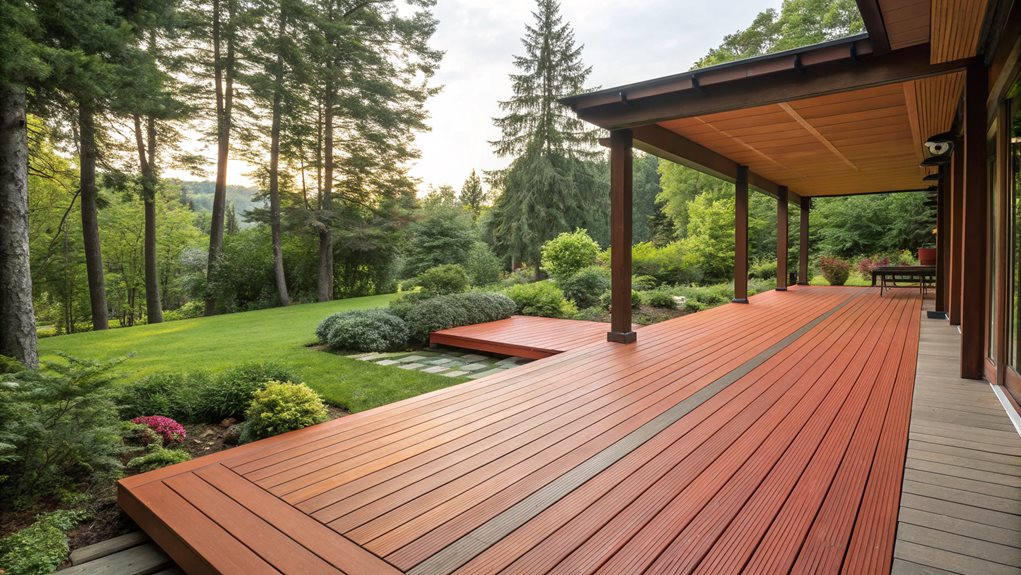
Prolonging a deck's lifespan hinges on strategic choices and vigilant management. Selecting high-quality materials lays the foundation for longevity. Durable options like ipe or pressure-treated lumber effectively resist rot and insects, while composite and PVC materials promise decades of use with minimal upkeep. Opting for durable composite materials, as seen in both residential decks and seaside environments, reduces maintenance needs and enhances structural integrity. Equally important is diligent maintenance—annual cleaning and sealing protect wood against weathering and decay, extending the deck's life. Monthly sweeps remove debris that could trap moisture, preventing rot. Regular inspections are essential, allowing early detection of issues such as loosened nails or split boards. Professional construction reinforces these efforts, ensuring proper drainage and ventilation. Together, these measures foster a strong sense of belonging in the space, maintaining its beauty and functionality for years to come.
Increasing Home Value
Selecting the right materials and meticulously maintaining a deck not only extends its lifespan but also greatly impacts a home's value. Well-executed decks can enhance a home's curb appeal, complement architectural styles, and increase usable square footage. High-quality materials, especially composite or PVC, promise up to 63% value recoupment at sale. By investing in custom features—like built-in seating or stylish lighting—homeowners tap into design potential that attracts buyers, boosting perceived home value. An ideal deck tailors to local climates and lifestyle trends, a smart alignment that guarantees optimal return on investment (ROI). Timing the installation is key, as it determines immediate enjoyment and secures long-term value gain. Gazebo experts in the construction industry uphold eco-friendly design and construction practices, enhancing the longevity and environmental sustainability of decks.
Deck Building And Design FAQ
How Do Quality Materials Impact the Resale Value of My Home?
Investing in quality materials substantially enhances your home's resale value by ensuring durability, reducing maintenance costs, and increasing aesthetic appeal. High-quality decks attract potential buyers seeking longevity, ease of upkeep, and harmonious integration with the home's design.
Are There Eco-Friendly Decking Materials Available?
Yes, numerous eco-friendly decking materials exist, offering sustainability and performance. Options include locally sourced wood, fast-growing species, FSC-certified timber, composite materials, bamboo, and recycled HDPE, each contributing to ecological preservation and reduced environmental impact.
What Is the Installation Process for a High-Quality Deck?
The installation of a high-quality deck involves meticulous planning, securing permits, ensuring foundation stability, and proper attachment of deck components. Each step emphasizes alignment, durability, and compliance with codes, creating a safe and appealing outdoor space for communal enjoyment.
How Do I Choose the Best Support Materials for My Specific Deck Design?
To select ideal support materials, consider factors like material durability, aesthetic alignment, maintenance needs, and climate compatibility. Choose materials that balance longevity and style while meeting the environment's demands, ensuring your deck complements and enhances your living space.
Can Quality Support Materials Be Customized to Fit Unique Deck Layouts?
Yes, quality support materials can be customized to fit unique deck layouts. By selecting materials like aluminum or composite, you can match colors, adjust sizes, and guarantee structural integrity, fostering a tailored and cohesive outdoor living space.

